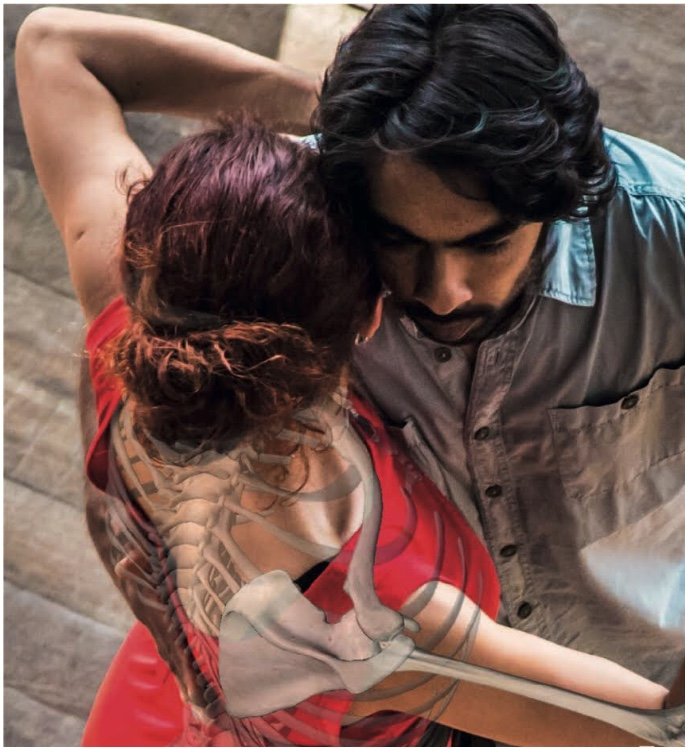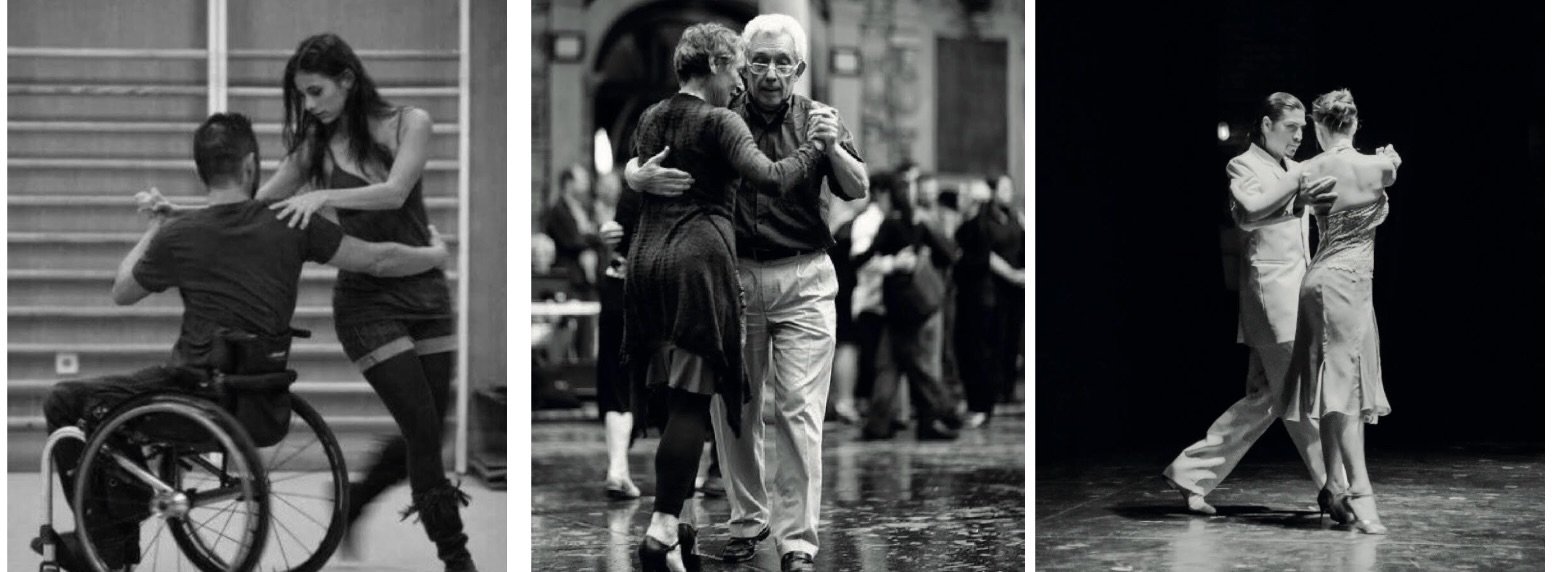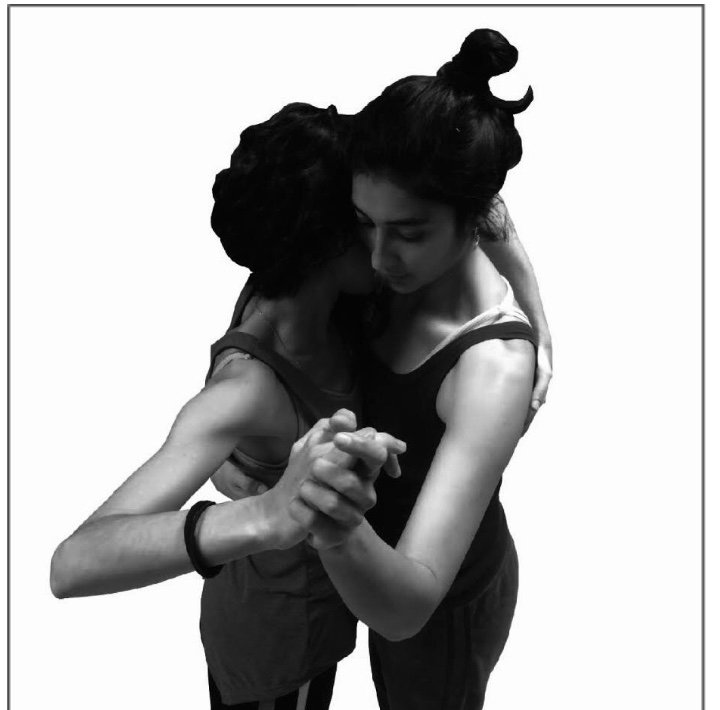Tango and the shoulder: a romance of science and sensuality
For about ten years I studied, danced, and then taught Argentine tango. During that time I observed fascinating biomechanical phenomena in the use of shoulder alignment of the dance embrace, which corresponded to principles of shoulder health I was learning in my Osteopathy and Biomechanics studies. I was fortunate to be able to discuss and dance these ideas with exquisite tanguera Candela Ramos, and biomechanics genius Frey Faust.
The following is my exploration and extrapolation of ideas about tango dancing, optimal technique and shoulder health. Focusing on:
Tango’s historical roots; how elevated physical sensitivity may have positively influenced shoulder alignment choices in this dance.
The anatomical context of the embrace: bones, muscles and myofascia.
Maintanence of the embrace for optimal dance connection and long term shoulder health.
Tango dancing as a shoulder integrity training, muscle maintenance, proprioception and rehab.
Tango health benefits; mental health, cognition, dementia prevention.
Tango
Argentine Tango is a social partner dance that is separate from the performative ballroom dance The Tango. Though patterns can be partly set and performed, Argentine Tango is fundamentally an improvised partner dance where movement ideas are suggested by a leader to a follower (and sometimes vice-versa) through a circular embrace. Clear physical communication between the dancers is essential to create the spontaneous but precise movements of the form. As a result, tango dancers have developed a highly functional embrace through which to communicate. Functional in the true sense; both physiologically and expressively.
Many years’ partner dancing has revealed to me the capacity for partner dancing to sensitise the shoulder to an appropriate range of motion. Partnered movement is inherently communicative; it involves “listening” and “speaking”. The body’s joints might act like links in a chain of communication, the shoulder joints are an important link in the chain of connection in tango because they form so much of the embrace. My experience is that due to the focus on the embrace in tango (and therefore shoulder alignment), the result of tango practice can be increased shoulder responsiveness, coordination and strength.
Tango may be an ideal activity for increasing shoulder sensitisation because of the subtlety and care central to the embrace; born of the unique historical context in which the dance emerged. (1)
Tangos unique roots
Men saturated 1920s Buenos Aires. It’s suggested that in order to be desired by one of the few women at a social gathering a man had to learn tango- the fashionable dance at the time, and lead in a way that was a pleasure to follow. It is told that Tangueros (male tango dancers) would practice most evenings in male only practice sessions. There they learnt to follow first, in order to experience what good leading felt like. Then they learnt to lead other men, who critiqued their leading. Only when deemed competent by their mentors were they taken to a social dance. (1)
men in Buenos Aires circa 1900. wikicommons
In this version of the history it’s understood that Tango evolved with a focus on the sensory experience of the follower and the qualities a follower might enjoy (1). This is a unique historical evolution in the creation of a dance, which may be a feature that created the subtle physical connection and exquisite communicative functionality we still see in tango today. While the context of today’s tango salons is a more balanced gender distribution, the desire to share an articulate, sensitive experience in this intimate dance is still very present. The embrace is the route through which this communication happens.
Copyright Candela Ramos
How does Tango work?
In tango, a key location for the initiation of movement is the centre of the leader’s chest, the space of the chest inhabited by the heart. While this might seem a romantic notion (and it is) the location of the heart above the centre of gravity makes it an ideal mass to topple (along with the surrounding chest) into space to generate momentum.
The embrace is formed by the arms and torsos of the dancers, which must maintain a frame that is capable of channeling momentum between their bodies.
photo Ka Yip
The position of the heart between the arms in the centre of the torso, places it at the centre of the embrace and directly above the multi axial junction between the thoracic and lumbar spine. Thus movement from the leaders heart can be directed through the embrace to the heart of the follower where a cascade of momentum flurries downward through this mobile central axis to drive the hips and legs.
The Axis Syllabus calls the central mobile junction between the upper and lower body the Anatomical Centre. This area pivots on the multi-axial thoracic-lumbar junction, including the lowest four thoracic vertebra and all their supporting structures ( as indicated in this image).
This area of the spine offers higher mobility than the upper thoracic spine above, which is restricted by the more rigid upper rib cage and the stable lumbar spine below. Myriad muscular chains span and support this junction. (2) Later we will see how some of these connections serve us as we dance.
The embrace has variations of openness and is adapted by dancers of different heights. Different distances between the bodies mean that sometimes the chests of the dancers are a contact point to channel momentum, and sometimes not. Either way, the bodies can form a complete chain of communication from heart to arms to heart, to centre and legs, so that partnered walking and variations on walking result. The ongoing cycles of communication between the legs, centres and embrace of the dancers can result in a complex loop of connection and momentum.
I describe this sequencing based on research into evolutionary principles of walking and current understanding of biomechanics, which suggest that the elevated mass of the body in verticality is the most efficient initiator of momentum through falling (2, 3, 4, 5 ). Rather than a whole body fall from the ankles say, the sequencing I articulate breaks down the fall so that each mass of the body is poured gradually into the wave of momentum communicated between the bodies. This might be used as an efficient means of continuing movement with minimal effort.
Now that we have an overview of how dancers bodies can relate in tango, let’s take a closer look at some detail about the structural and functional potential of the shoulder in the embrace.
Shoulder function
According to anthropological science, the upper limb has evolved to engage in activity that is in front of the body in order to serve the important senses of vision, smell and taste (2, 4, 5, 6,). As such, the articulations of the hand, wrist, elbow and shoulder complex are highly developed, sensitive tools. We are able to draw, pick a flower, or catch a ball owing to the great dexterity and coordination offered by the multiple joints. This forward offering of the arms also serves us to make human contact; to cradle a baby, fight, or to embrace.
Photo Jürgen Ohneiser. Skeleton overlay assistance Elvira GroB
The gleno-humeral joint (GH), has evolved to offer the most effective joint contact when reaching forward. The abrazo is functional when it respects this and makes use of the optimal range of the shoulder joint.
In this image we see a standard moment in the embrace. The imposed skeleton image illustrates the idea that the joint surfaces between the humerus (upper arm bone) and scapula (shoulder blade) appear contiguous in this relationship.
Why might this be useful?
Shoulder Joint Parameters
Drawing Domenico Trombetti
The gleno-humeral joint is angled on a forward diagonal due to scapular position on the curve of the ribs. This angle defines the orientation of maximal contact or joint centration of the humerus and the glenoid fossa of the scapula. Movement directed along the humerus in this vector should transmit most directly into the rest of the shoulder and onward, with minimal muscular accommodation. The benefits of this are that pertinent muscular tension creates ease and efficiency, both in the long and short term. (6)
Drawing Domenico Trombetti
Movement in the GH is limited by the acromion and coracoid process, which form the roof of the joint. Therefore, in order to elevate the arm above horizontal within the limitations offered by the joint, the scapula must rotate to orient the GH upwards.
When we look more closely at upper limb movement it appears that a complex elliptical pathway may offer joint centration throughout the range of the joints.
The diagram below suggests the arc of movement described by the arm when all elements of the shoulder remain integrated. The green line shows the arc of integrated movement available at the GH. Note that internal and external rotation as well as adduction and abduction are needed at specific moments of the curve to accommodate joint centration. The red line suggests the increased range of movement available when the thoracic spine accommodates and amplifies GH movement (2).
Drawing concept Zoë Solomons in collaboration with Frey Faust. Drawing Domenico Trombetti.
Dynamic alignment as shown in the diagram maybe be optimal for all aspects of the shoulder; neurological, muscular, capsular and bony. When we consider the tango embrace we see it is an in practice test of a dancers capacity to respond to and maintain joint integrity. The constantly changing relationship of the dancers bodies in tango requires tuning-in to subtle changes of angle within the gleno-humeral joint if the frame of the embrace is to be accurately maintained.
In these images we see some commonly used ranges of the abrazo. The dancers adapt their arm position to different phases of movement but maintain shoulder integrity.
Middle image: Alexander Zabara http://tangoimage.com/. Extensive internet searching yielded no author for outer pictures. If the is your photo or you know the source please get in touch.
Shoulder Muscle Function
So what acts to maintain this integrated relationship? The ligaments and joint capsule of the GH maintain a certain amount of joint integrity. However, due to the large range of motion needed for dexterity, sensory monitoring and reciprocal muscular engagement to guide movement is vital for shoulder integrity and optimal function. (8, 10)
Locally, GH angle adaption is managed by the rotator cuff muscles. As the embrace only functions well with the GH in a place of integrity, tango practice could be adopted as a means to create a precise and appropriate training context for integrity and rotator cuff responsiveness.
Muscular engagement to maintain joint relationships is possible due to neurological perception in and around the joints and myofascia. Neurological detection of movement in a joint is called proprioception, it is key to joint function and injury prevention, reportedly one of the most important factors in maintaining joint health (5,6,9). Could tango offer a creative way to train shoulder proprioception and muscular engagement?
Muscles up close
Essential to shoulder alignment is the role of the serratus anterior in angling the scapula. The serratus rotates the bottom tip of the scapula down and forward around the ribs, this rotates the GH up so that the arms can reach above the horizontal with GH integrity maintained.
The muscles in shoulder-foot connection.
The trapezius shown here top right, is a large flat muscle that spans the neck, shoulder and mid back, it’s another local player in the angling of the scapula. It also facilitates important cross body connections as it connects to the Anatomical Centre, here the thoraco-lumbar fascia continues myofascial tension to the gluteus muscles, and muscles of the hips and legs. Channelling momentum through the myofascial web may be an aspect of efficient movement generation; fascia exerts tension which allows passive lag and lead through tissues, amplifying muscular contractile force. (9)
Photo Michael Pereckas. Muscle chain drawing Zoë Solomons.
Shoulder injury
So why is all this so important? Well, while it is truly beautiful to have the physical integrity to maintain connection with another person while dancing, what happens when we have the opposite of integrity is disconnection, strain and ultimately, injury. Shoulder muscular strain occurs with excess tension or poor alignment.
Photo Zoë Solomons
In this image (14) we see the followers shoulder pushed out of integrity behind her. This would commonly cause strain to the anterior shoulder ligaments and muscles as well as reduce the efficiency of information transfer in to the followers body.
This happens due to lack of resistance from the follower into the leaders hand, or by a lack of sensitivity from the leader as to the amount of pressure a follow is able to resist. Of course, the bigger picture is that connecting to an efficient use of momentum through the whole body reduces the need for grappling in the arms.
Photo Zoë Solomons
Here (15) both partners are resisting external rotation of the humerus (lifting the elbow up rather than letting it drop). Maintaining this fixed elevation of the elbow is a common habit among dancers that causes fatigue due to the imbalance in posterior and anterior shoulder tissues. The excess tension required to maintain this fixed position may reduce efficiency of movement transmission. This kind of pushing can be eased by connecting to the posterior chain of muscles shown in image 13. Again, inviting efficient whole-body management of force.
There is no data available on rates of injury in tango relative to those in sports. However, my decade of experience on the social dance floor and in the treatment room suggest that lower back and knees seem to be more common sites of injury. Tango seems to largely avoid the common shoulder injuries seen in sports: instability, dislocation, and impingement, which occur in sports where repetitive, high velocity, large range or high intensity movements occur (8,10) like throwing a cricket ball or swinging a tennis racket.
Myofascial context
Research into myofascial function suggests that multi-axial, unpredictable movements are essential for engagement through the multidirectional fibres of myofascia (10). Tangos’ improvisational framework provides exactly these movement challenges. For rehabilitation, coordination of scapula-thoracic rhythm (the rhythm at which the shoulder muscles fire in harmony in order to stabilise and mobilise) must be trained in a context of proprioception and functional movement (8,9). I would suggest the maintenance of the embrace in tango could provide a set up for this training that is creative, social and complex.
NB In the case of injury rehab other supportive aspects such as physiotherapy should also be in place. (11)
Additional benefits of tango
Researchers at Mcgill University have found evidence to suggest that tango dancing may have benefits to physicality as described above, but also in the areas of cognition, mindfulness and treatment of Dementia. Tango has been successfully shown to be an effective way to practice mindfulness as a treatment for depression. It’s suggested that the responsive, improvisational nature of the dance as well as the emotional support from close body contact may be key factors.
Tango may be useful in the prevention and treatment of dementia. MRI scans show enhanced brain activity when dancers perform multitasking activities inherent in tango such as dancing steps with their partner whilst also navigating space on a busy dance floor. (12)
This research supports our understanding that holistic activities; those which satisfy us on many levels eg social, cognitive, emotional, physical and spiritual are highly beneficial to our health.
Summary
That’s the end of this brief, broad exploration of shoulder function in Argentine tango. I hope you’ve found it interesting or even useful. Here’s a recap of what was covered:
Tango’s historical roots; how elevated physical sensitivity may have positively influenced shoulder alignment choices in this dance.
The anatomical context of the embrace: bones, muscles and myofascia.
Maintanence of the embrace for optimal dance connection and long term shoulder health.
Tango dancing as a shoulder integrity training, muscle maintenance, proprioception and rehab.
Tango health benefits; mental health, cognition, dementia prevention..
A final note
As a functional movement teacher and health practitioner I'm often asked how I can justify wearing high heels to dance. Well, think back to the explanation of how the hearts of the dancers interact to create movement, how the raised the centre of gravity allows the body to tip into momentum and fall with ease. Now imagine that majority of followers are female and therefore more likely shorter than the male leader. Practitioners of martial arts or contact improvisation will know that to manipulate another body, bending the knees to drop the centre of gravity is to their advantage. Rather than having men dance crouched down all evening, tango dancers and other ballroom dancers have elevated the centre of gravity of the follower instead, with heels.
Author: Zoë Solomons, BA, M.ost.
For workshops with Zoë covering these and other ideas in depth check my upcoming classes page.
For more articles on applied anatomy and universal motion principles search www.axissyllabus.org To give welcome feedback or if you have questions on this article contact me.
References
Tango. Christine Denison. Christine Deniston, 2007.
The Axis Syllabus. Frey Faust. Available online at: <www.axissyllabus.org>
The Spinal Engine. Serge Grakovetsky. Springer-Verlag, 1989.
Sapiens: A Brief History of Humankind. Yuval-Noah-Harari. Vintage, 2015.
Gray’s Anatomy. R. Drake, A. Wayne Vogul, A. Mitchel. Elsevier, 2010.
Understanding joints. Berney Kingston. Nelson Thornes, 2000.
Anatomy Trains Thomas Myers. Elsevier, 2014.
Musculoskeletal Injuries and Pain in Dancers A Systematic Review Update. C. Jacobs, C. Hincapié, J Cassidy. Volume 16, Number 2, 2012. Journal of Dance Medicine & Science.
Fascia: The tensional network of the human body. R. Schleip, T. Findlay, L, Chaitow, P, Huijing. Elsevier, 2012.
The shoulder in sport. A. Fusco, F. Musarra, A. Foglia, M. Testa. Churchill Livingston, 2008.
Sports injury and management. Christopher Norris. Elsevier, 2004.
Benefits of tango. Patricia McKinley. Available online at: < http://www.todotango.com/english/history/chronicle/450/The-benefits-of-Argentine-tango-dancing/>











